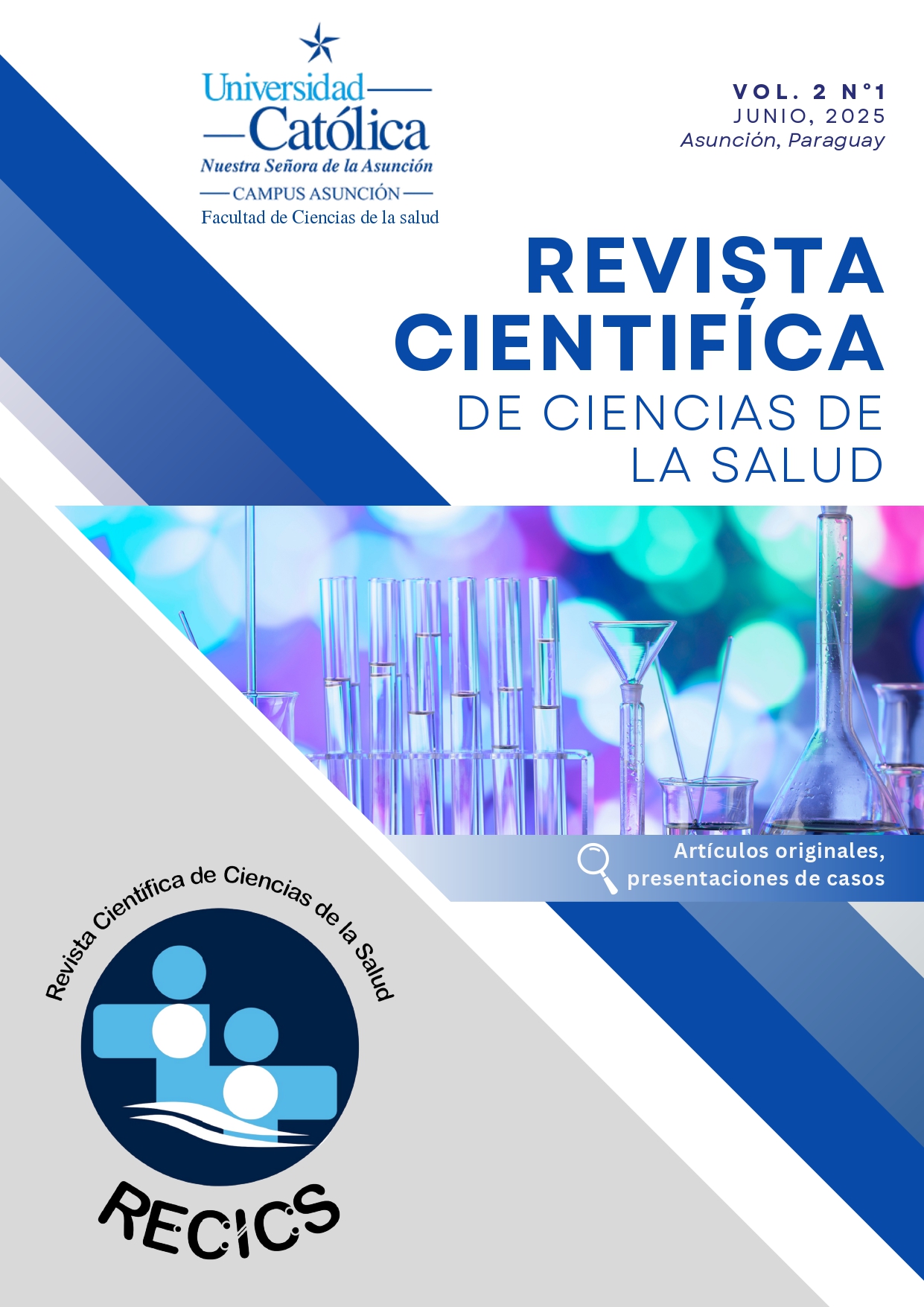Microbiological characteristics and antimicrobial resistance of pathogens isolated in urine cultures from patients hospitalized in a pediatric service
Keywords:
drug resistance, pediatrics, etiological agent, pediatric hospitalsAbstract
Introduction: Antimicrobial resistance in pediatric infections represents a growing challenge for public health. In Paraguay, there is limited information about resistance patterns in the pediatric population, especially in hospital centers outside the capital. Objective: To determine the frequency of antimicrobial resistance of germs isolated in urine cultures of patients admitted to the pediatric service of the General Hospital of Luque, during the period from October 2023 to October 2024. Methodology: Observational, descriptive, and retrospective study. Medical records and laboratory results of 121 hospitalized pediatric patients who underwent urine culture were analyzed. Demographic characteristics, microbiological results, antimicrobial resistance and sensitivity patterns, and treatments used were evaluated. Results: During the study period, 121 patients with a diagnosis of urinary tract infection were hospitalized, of which 67.77% were female patients, with a predominance of <1 year of age (38.02%). Of the total urine cultures, 32.81% were positive, with a predominance of monomicrobial cultures (85.71%). Escherichia coli was the most frequent pathogen (69.23%), followed by Klebsiella pneumoniae (7.69%). ESBL strains were identified in 7.69% of cases. The highest resistance was observed against Ampicillin/Sulbactam (35.71%) and Cotrimoxazole (23.81%), while the highest sensitivity was to Gentamicin (69.05%) and Cefazolin (57.14%). The most commonly used treatment was cefotaxime (58.67%), with a predominant duration of 4-7 days (70.25% of cases). Conclusion: The findings demonstrate a considerable frequency of antimicrobial resistance, with specific patterns that should be considered in the selection of initial empirical treatment. The high prevalence of E. coli and the emergence of ESBL strains underscore the relevance of constant surveillance and the need to establish strategies for rational antibiotic use in the pediatric population.
Downloads
References
1. Organización Mundial de la Salud, Organización de las Naciones Unidas para la Educación, la Ciencia y la Cultura. Hacer que todas las escuelas sean promotoras de la salud: Pautas e indicadores mundiales. Ginebra: Organización Mundial de la Salud (OMS); 2021.
https://iris.paho.org/bitstream/handle/10665.2/55711/9789275325124_spa.pdf.
2. Organización Mundial de la Salud. 70ª Asamblea Mundial De La Salud: Punto 12.2 del orden del día provisional, 10 de abril de 2017. 2017. http://apps.who.int/gb/ebwha/pdf_files/WHA70/A70_12-sp.pdf.
3. Shkalim Zemer V, Ashkenazi S, Levinsky Y, Richenberg Y, Jacobson E, Nathanson S, Shochat T, Kushnir S, Cohen M, Cohen AH. Pathogens Causing Pediatric Community Acquired Urinary Tract Infections and Their Increasing Antimicrobial Resistance: A Nationwide Study. Pathogens. 2024 Feb 24; 13(3): 201. doi: 10.3390/pathogens13030201. Erratum in: Pathogens. 2025 Feb 05; 14 (2): 150. doi:
10.3390/pathogens14020150. PMID: 38535544; PMCID: PMC10974911.
4. Paredes PL, Celis G, Toapanta IG, Bravo LA. Epidemiología de la infección del tracto urinario en niños, Hospital General de Ambato, Ecuador. INSPILIP. 2017;1(2):1-17. DOI: 10.31790/inspilip.v1i2.29.g34
5. Eremenko R, Barmatz S, Lumelsky N, Colodner R, Strauss M, Alkan Y. Urinary Tract Infection in Outpatient Children and Adolescents: Risk Analysis of Antimicrobial Resistance. Isr Med Assoc J. 2020 [acceso 26/07/2021]; 22(4): 236-40. https://www.ima.org.il/FilesUploadPublic/IMAJ/0/423/211584.pdf.
6. Falup O, Leibovitz E, Vorovenci C, Lixandru R, Rochman F, Monescu V, et al 8. First UTI episode in life in infants <1 year of age: Epidemiologic, clinical, microbiologic and disease recurrence characteristics. Pediatr Neonatol. 2020; 61(6): 613-19. DOI: 10.1016/j.pedneo.2020.07.008.
7. Shaki D, Hodik G, Elamour S, Nassar R, Kristal E, Leibovitz R, et al 9. Urinary tract infections in children < 2 years of age hospitalized in a tertiary medical center in Southern Israel: epidemiologic, imaging, and microbiologic characteristics of first episode in life. Eur J Clin Microbiol Infect Dis. 2020;39(5):955-63. DOI: 10.1007/s10096-019-03810-w.
8. Pérez K, González Y, Pupo A, Santana J, Guilarte C, Vázquez G. Caracterización clínico-humoral de pacientes pediátricos con infección del tracto urinario. Rev 16 de abril. 2020 [acceso 23/02/2022]; 59 (278): 1-4. http://www.rev16deabril.sld.cu/index.php/16_04/article/view/1023.
9. Milá M, Aties L, Torres I. Urocultivo y parcial de orina en el diagnóstico de las infecciones del tracto urinario. Rev Elec Dr. Zoilo E. Marinello Vidaurreta. 2020 [acceso 21/02/2022]; 45 (1): 1-5. http://revzoilomarinello.sld.cu/index.php/zmv/article/view/2038
10. Bello ZL, Cozme Y, Morales I, Pacheco Y, Rua M. Resistencia antimicrobiana en pacientes de edad pediátrica con infección del tracto urinario. Rev Elec Dr.Zoilo E. Marinello Vidaurreta. 2018 [acceso 20/02/2023]; 43 (2): 1-6. https://revzoilomarinello.sld.cu/index.php/zmv/article/view/1271
11. Carriel MG, Ortiz JG. Prevalencia de infección del tracto urinario y perfil de susceptibilidad antimicrobiana en Enterobacterias. Rev vive. 2021 [acceso 20/01/2023]; 4(11): 217-28. https://revistavive.org/index.php/revistavive/article/view/103 18.
12. Molin C, Del Valle E, González L, Figueredo L. Infecciones urinarias en niños con vejiga neurogénica y los patrones de resistencia a los uropatógenos más frecuentes. Mem. Inst. Investig. Cienc. Salud. 2018; 16 (3): 44-50. DOI:
10.18004/Mem.iics/1812-9528/2018.016(03)44-050






